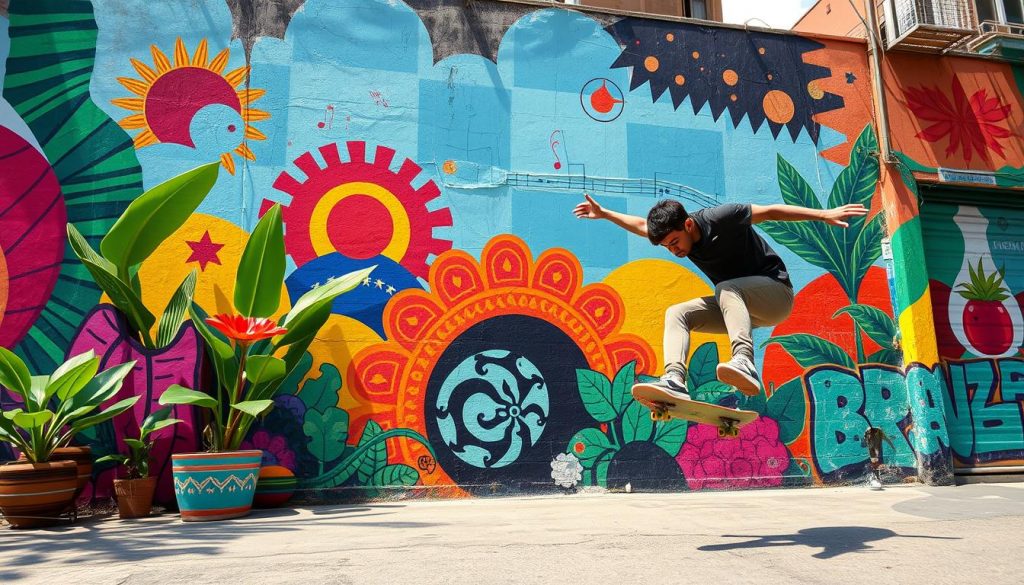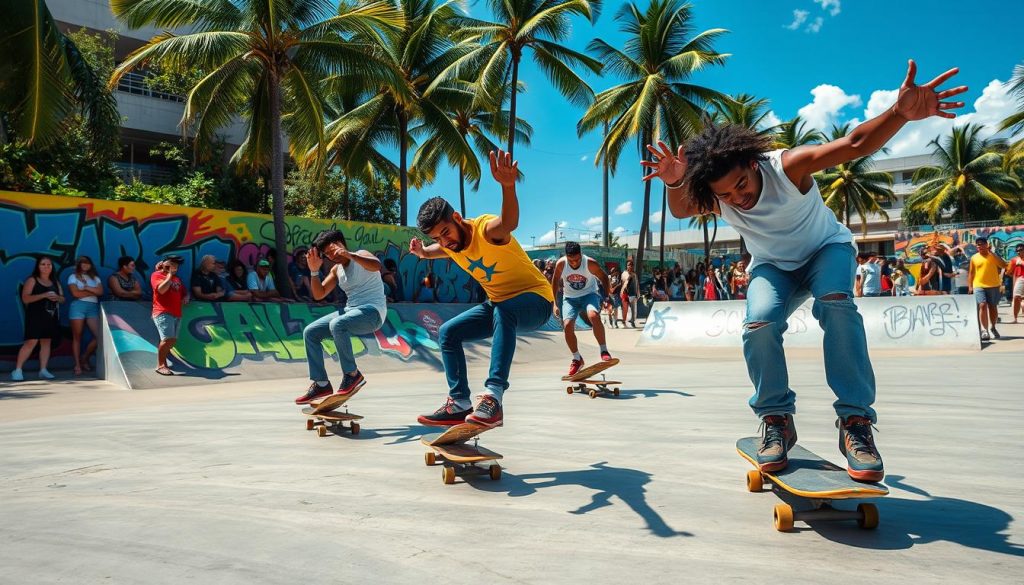The Skateboarding Culture of Brazil
The skateboarding culture in Brazil is full of life and creativity. It’s all about community and self-expression. From Rio de Janeiro’s busy streets to São Paulo’s urban scenes, skateboarding is a big part of Brazilian life.
Anúncios
Skateboarders in Brazil are passionate and dedicated. They meet at big ramps and famous street spots. There, they show off their skills and bond with each other.
Let’s explore the world of Brazilian skateboarding together. We’ll look at how it’s grown, its cultural impact, and the events that celebrate it. We’ll also talk about the challenges skateboarders face today.
Join us as we dive into this vibrant skateboarding culture. It’s a world that deeply influences the lives of many in Brazil.
Overview of Skateboarding in Brazil
Brazil’s skateboarding history started in the late 1970s. The sport came from international trends but quickly became unique. The local environment shaped the style and techniques of Brazilian skaters.
Anúncios
Urban areas, especially big cities like São Paulo, became key for skateboarding. Many skate parks in Brazil helped grow talent and build community. These parks offer ramps and street courses for skaters to improve and be creative.
Skateboarding is a big way for Brazilians to express themselves. Skaters often use their surroundings in their tricks, showing off Brazilian culture. They also join local events to show their skills and help grow the skate culture.
Stars like Rayssa Leal have made Brazil famous in skateboarding. She leads the World Skate Rankings. To see how Brazil became a top skateboarding nation, check out this link.
The Growth of Skateboarding Culture
Skateboarding culture in Brazil has grown a lot since the 1980s. It started as a small activity but became a big part of the country. This change came from grassroots movements that valued individuality and rebellion.
These movements led to more skate parks and community events. This made skateboarding more popular and fun for everyone.
In the 2000s, skateboarding got even bigger thanks to social media. Brazilian skaters could share their skills online. YouTube and Instagram helped them gain fans worldwide.
Now, many brands support skateboarders, showing how big the sport is. This support helps athletes and brings more youth into skateboarding. The culture welcomes everyone, making it more exciting and diverse.
| Growth Factors | Impact on Youth |
|---|---|
| Grassroots Movements | Increased Community Engagement |
| Social Media Influence | Broadened Talent Recognition |
| Sponsorship from Brands | Enhanced Opportunities for Skaters |
| Emergence of Skate Parks | Accessible Skateboarding Spaces |
This growth has created a lively culture. It lets people be creative and feel part of a community.
Influence of Brazilian Music and Art
Brazilian art and music deeply influence skateboarding culture. Genres like samba and bossa nova inspire skaters. These rhythms bring Brazil’s vibrant energy to skateboarding, changing how skaters move and express themselves.

Brazilian street art also shapes skate culture’s look. Urban areas are filled with bold, colorful art. Artists like Os Gêmeos show how street art and skateboarding are connected. Their unique styles make public spaces more engaging for skaters.
This mix of music and art gives Brazilian skateboarding its own identity. It celebrates local culture and brings skaters together through creativity and self-expression.
Skateboarding Culture and Youth Identity
Skateboarding culture is key in shaping youth identity in Brazil. It gives young people a special way to express themselves and feel empowered. Skateboarding lets them show their love for freedom and adventure, which is important during their teenage years.
The skateboarding community among youth creates strong bonds and a sense of belonging. By meeting up and skating together, they build friendships that help their mental health. These friendships help them grow emotionally and develop healthier relationships.
Skateboarding also encourages individuality as youth deal with society’s expectations. It’s a creative outlet for them to show their unique styles and personalities. As skateboarding grows, Brazilian youth see it as a way to follow their dreams and make lasting friendships.
Main Skateboarding Events in Brazil
Brazil is a big name in skateboarding, hosting many important competitions every year. Events like the Street League Skateboarding (SLS) series draw skaters from all over. They get to show off their skills and compete at the top level. The Brazilian Skateboarding Championships also highlights the best skaters in the country.
These events are not just about winning. They bring people together, creating a community of skateboarding fans. Skateboarding mixes people from different backgrounds, all united by their love for the sport. Events like “Skate the World” make the scene even more lively, blending skateboarding with Brazil’s music and culture.
| Event Name | Location | Type | Date |
|---|---|---|---|
| Street League Skateboarding (SLS) | São Paulo | Competition | April |
| Brazilian Skateboarding Championships | Various Cities | Competition | August |
| Skate the World Festival | Rio de Janeiro | Festival | November |
| Street Skateboarding Cup | Belo Horizonte | Competition | September |
These events are key in spreading skateboarding culture across Brazil. They make the country a thrilling place for skaters and fans.
Notable Brazilian Skateboarders
Brazil’s skateboarding scene is vibrant and full of talent. Many Brazilian skateboarders have made a name for themselves both at home and internationally. Their achievements are impressive.
Bob Burnquist is a legend in skateboarding. He’s known for his groundbreaking tricks and has set new heights in the sport. His career shows that Brazilian skaters can compete with the best worldwide.
Letícia Bufoni is a standout in women’s skateboarding. She has won many awards and inspires young skaters. Her success highlights the growing role of female athletes in skateboarding.

Skaters like Pedro Barros and Pamela Rosa have made Brazil a force in skateboarding. They perform well in competitions globally. Their success boosts Brazil’s reputation in the sport.
The upcoming Oi STU Open in Rio de Janeiro will feature these talented athletes. It will draw fans and competitors from all over. The event highlights the role of these athletes in Brazilian skateboarding.
| Skater Name | Notable Accomplishments | Contribution to Sport |
|---|---|---|
| Bob Burnquist | Multiple X Games gold medals | Pioneer of innovative tricks |
| Letícia Bufoni | Numerous World Championships | Inspiration for female skaters |
| Pedro Barros | X Games podium finishes | Leading figure in vert skateboarding |
| Pamela Rosa | World Skateboarding champion | Role model for young athletes |
Challenges Facing Skateboarders in Brazil
Skateboarding is a vibrant culture in Brazil, but many challenges in Brazilian skateboarding need to be solved. Skateboarders face big hurdles like finding quality skate parks and training spots. This is especially hard in areas that don’t get much help.
The way people see skateboarding is a big problem. It’s often seen as not a real sport, which stops new people from joining. This makes it hard for skateboarding to grow.
Safety is another big worry. The risks of skateboarding scare off some people, especially parents thinking about it for their kids. Also, rules in public places make it hard for skateboarders to do what they love.
It’s crucial to tackle these issues facing skateboarders for skateboarding to thrive in Brazil. By fixing problems like access, perception, safety, and rules, more people can enjoy skateboarding.
| Challenges | Description |
|---|---|
| Limited Access | Inadequate skate parks and training facilities, especially in poorer areas. |
| Societal Perception | Skateboarding viewed as a fringe activity rather than a legitimate sport. |
| Safety Concerns | Risks deter some from participating, impacting community growth. |
| Regulatory Restrictions | Rules and regulations limiting skating in public spaces. |
Skateboarding Culture and Fashion
Skateboarding culture and fashion in Brazil are a perfect mix. They create a lively scene that shows off local spirit. Skaters in Brazil use their clothes to share their unique stories and bond with others. The skate fashion in Brazil stands out with its bright colors and cool designs, capturing the street vibe.
Brands like Aloha and OUS are big in the Brazilian skate scene. They make clothes that are both comfy and stylish, perfect for skaters. Skaters often wear baggy pants, loose shirts, and trendy shoes. These clothes help them move freely and look good doing it.
The urban art and music, like funk and hip-hop, really shape skate fashion in Brazil. This mix shows up in clothes with fun designs or inspiring words. Skaters wear these clothes every day, mixing sportswear with street style.
Skateboarding in Brazil is more than just a sport; it’s a lively culture. It combines fresh fashion with artistic flair. The skateboarding style here is always changing, blending old traditions with new ideas.
Conclusion
The Brazilian skateboarding culture is full of creativity, community, and strength. It has grown from the country’s music and art scenes. This mix has given Brazilian skateboarders a unique identity known worldwide.
The future of skateboarding in Brazil is bright. It will grow with new trends in fashion and tech. Skateboarders are always finding new ways to innovate, keeping the scene exciting for everyone.
Looking ahead, Brazilian skateboarding is more than tricks and style. It’s about innovation and community that inspires new skaters. This summary shows that Brazilian skateboarding’s future is full of promise, with a heart that keeps beating strong.
